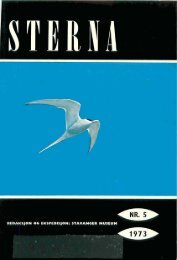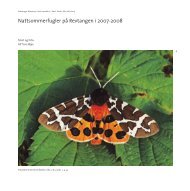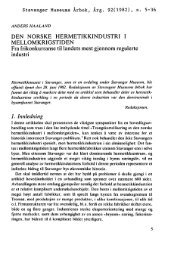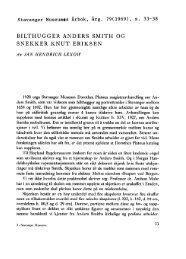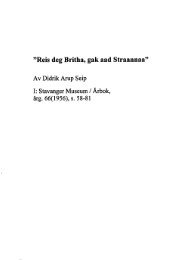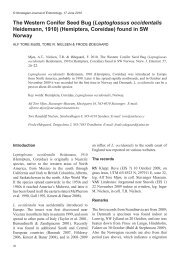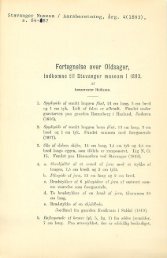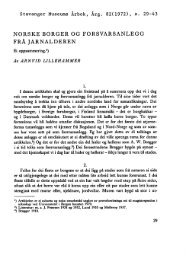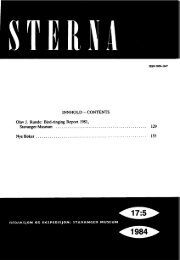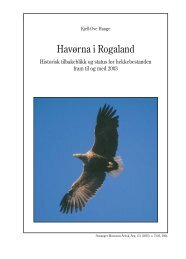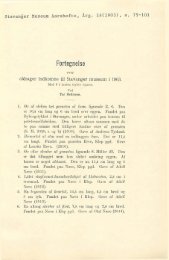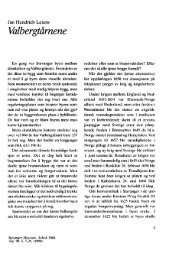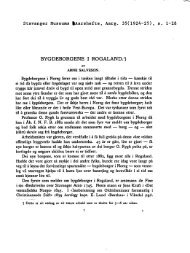Sterna, bind 1 nr 23 (PDF-file) - Museum Stavanger
Sterna, bind 1 nr 23 (PDF-file) - Museum Stavanger
Sterna, bind 1 nr 23 (PDF-file) - Museum Stavanger
- No tags were found...
Create successful ePaper yourself
Turn your PDF publications into a flip-book with our unique Google optimized e-Paper software.
STERNANo. <strong>23</strong>OpusculnSeries ZoologicnNr. <strong>23</strong>D. M. GRIFFIN, C. J. O. HARRISON and M.K. SWALESA REVIEW OFORNITHOLOGICAL OBSERVATIONSAT LISTA, SOUTH NORWAYi. INTRODUCTIONThe Lista peninsula is situated in the extrcme south-west ofNorway (58" 5' N., 6" 35' E.), 17 km. W.N.W. of Lindesnes,the southernmost point of the country. Such a position near thecentre of the N.W. European migration system, allied with certaintopognphical peculiarities (sec below), suggested that thepeninsula might provide an excellent observatory for the studyof bird migration. In the five autumns 1950-1954 (for dates,sec Introduction to Systematic List), ornithologists, mainly fromthe Cambridge Bird Club, have visited Lista and many ofthe observations have already bccn published (sec List of Refcrences).The purpose of the present paper is to review the stateof our knowledge derived from thesc observations. Lista has onlybeen visited twice in spring and this aspect is summarised in aseparate section.(a) Gc~acral Dcscription of the Arca.The Lista peninsula is irregular in shape but is c. 16 km.(E-W) by c. 10 km (N-S) and is connected to the mainland
two by a line running from Vanse south along the west shore ofNeseimvann. To the west of this line, in the area here referredto as West Lista, the bed-rock of gneiss is largely overlain bypeat, but glacial boulders and other inoraine materials occur. Thewhole area tends to be barren and marshy, with poor fields andlittle cover. The area to the east of the line (East Lista) is gentlyundulating and contains the three largest lakes of Lista: Neseimvann,Hanangervann and Krågnesvann. Here there is better soiland more cultivated land and woodland and there is therefore amuch wider range of habitat in the east than in the north or west.The coast-line of both E. and W. Lista is sandy except in thccxtreme east, where it is rocky, and in the extreme west, wherethe sand is replaced by large boulders.
By a combination of these direct and indirect methods ofobservation, it was hoped to discover not only the pattern ofmigration on Lista itself, but also to show something of the placewhich Lista occupies in the general migration of birds fromNorway and Sweden in the autumn. In addition, activities suchas trapping of birds for ringing would give some idea of whichactivities could be the most profitable method should a morepermanent observatory be established.2. A NOTE ON PLACENAMES.When the migration studies at Lista were statied some difficultywas experienced in discovering the names of the precise placeswhere birds were recorded. All that could be done was to referto the nearest place that was named on the map. For example,aGrimsby~, in some earlier reports, refers to the wooded slopeson the north side of the Farsund-Vanse road where it passesthe northern end of Hanangervann; while aKjørrefjord~ refersin most cases to the wooded peninsula between Helvigfjord andKrosnessundet which is marked on the map as statens planteskolev.In some cases more exact information has now beenobtained and it is felt that the correct names should be used.These names were not known when the present report wascompiled and it was decided that, for the most part, the sameplacenames should be used in this report as in the previous fiveannua1 reports. In a11 cases howcver these notes should be bornein mind, and any future report will use the correct name whereeverpossible.On the south side of the Lomsesanden-Eigvågroad there isan area of high ground, the top of which is divided into severalheights by narrow cols. The highest point on the southern,seaward edge of this area is known as S 9 n d e r h a l v h e i a .This is the point from which the early morning observations atthe Loshavn end are always made, and it is the hill which isreferred to in all the reports, including the present one, aseEigvågv. The highest point on this hill area is further to thenorth and is known as S t o r e V a r å s e n . It was on this pointthat an additional observer was stationed on some mornings in
over Eigvåg. It is ccrtain that they come from the N.W. but donot pass either Lista Fyr or, rathcr less certainly, Varnes Fyr.As the first migrants pass at first light, it seems likely that theseoriginatc on the plain itself bur others may wc11 pass straightthrough from farther N. through the vallcys of N. Lista to theedge of the plain and so straight on to Eigvlg and the S.E. Inany case, most birds must enter Lista via the valleys of the northrather than by a strictly coastal passagc.Again the breadth of the stream over Eigvag is quite uncertain.It is possible that we are, in fact, only obscrving the southernseaward edge of a wide, and possibly broken, stream rather thanbeing astride a narrow one. Further observations are needed ilongthe edge of Farsund fjord running to the N. from Eigvåg.Similarly, therc is no information as to the origin of N.W.migrants at Lista Fyr. They certainly do not pass Eigvåg andit is presumed that they too originate cithcr on the plain or enterit through the vallcys of the north.The gcncral picture arising on Lista itself is tliat of a gradualdrift of birds onto the plain from approximately N. during theday accompanied by a possiblc through passage in the early morning.The direction taken in leaving Lista, S.E. or N.\V., secmsto be largely influenced by the wind if the weather is othcrwisefavourablc (sec ncxt section) .'(b) The I~~fltrorcc of Weather on Migratiojr.The influcnce of the weather on the occurrencc of migrationhas been examined by many (but see Jenkins, 1953, for referencero Lista). In general, large scalc movements are correlated withanticyclonic conditions over Scandinavia i.c. clcar skies, lightapprox. eastcrly winds and a drop in tcmpcrature. Such conditionsnormally Icad to S.E. passage over Eigvåg but the strongN.W. passages at the Fyr tend to be correlated with similarweather but with an approx. westcrly wind. The latter conditionsare oftcn associated with temporary ridges of high pressure tothe S. of Lista. The evidence providcd by our daily census ofthe birds in the Fyr area shows that the movements of nightmigrants follow closely those of diurnal oncs.
On days of high wind (greater than force 4) it is unusual forthere to be much migration. In high winds, the birds fly higherif flying with the wind and vice versa.(c) The place of Lista irt Nortuegian Migrution.The consideration of migration on Lista itself (above) wasrendered difficult by the absence of data from anywhere else inNorway. This lack of information renders almost impossible anyconsideration of the place of Lista in the larger picture. Thefollowing discussion must therefore be considered as tentativein the extreme.The only certain conclusion that can be drawn is that themain direction of diurnal migration of land birds is S.E. fromLista along the Norwegian coast towards the Skagerak and Denmarkand not \V. or S.W. towards Britain. Raptors, waders anddrifted migrants, at least, have been shown by ringing returnsto make the direct North Sea crossing.If the preferred direction of migration for most species inNorway is approximately S.W. as has been inferred for Sweden,Finland etc. (Rudebeck, 1910), it would be expected that manybirds would be divened in a southerly direction by the mountai<strong>nr</strong>ange running north-south throughout Norway. Thus onlythose birds breeding west of the watershed would be expected topass through Lista in autumn. In the last three weeks of Sept.and the first of Oct. in each year c. 30,000 birds have passedEigvåg during the morning watches. (Chaffinches-c. 39 %,Bramblings-c. 11 C/c, Siskins-c. 7.7 5, Meadow-Pipits-c. 7.3%) Now these numbers, although quite large in themselves, areunlikely to represent more than a small fraction of the populationsbreeding west of the central ranges. This could be explainedif the roughly S.E. coastal passage produced by the S.W. migrantshitting the coast and turning along it was fragmented into manystreams by the broken nature of the coastline and hinterland ofS.W. Norway. The Eigvåg passage would then be bur one ofa number of streams passing along the valleys and fjord systemsin a S.E. direction towards the extreme S. Norway. That this isthe case seems to be probable.
It is not profitable to speculatc further until more data areavailable. Apart from a few obscrvations of S.S.E. migration atJacren, ncar <strong>Stavanger</strong>, there appcars to be no information fromclscwhere in Norway. The data from Utsira are of littlc hclpowing to the isolated position of the island. It would be of particularintcrcst to know the position along thc S.E. coastlinc ofNorway froni Oslo to Lindesnes. If, in fact, large numbers ofiiiigrants are deflected south by the easterly cdge of the mountains,then a considerable concentration of birds, at least as largeas that at Lista, should occur therc.It is, of course, possible that thc N.W. passagc which occasionallyoccurs on Lista is coniposed of birds which have migratcdS.W. along the S.E. Norwegian coast and overshot the southerntilostpoint. Thcre is no evidcncc to support this, howcver, andit seems more likely that the N.W. movement is in the natureof a local crcddy~ in the niigration strcam induced by ratherunusual and temporary weather conditions.(il) Notcs o11 Selecfed Sjecies.One of the most interesting fcatures brought out by ourobscrvations is the evidcnce of niigration in what, to British eyes,are relatively sedentary species. It seems quite cenain that thegreat majority of woodland specics such as the Nutcracker,Goldcrcst, Nutliatch, Tree-Crccpcr and the tits and woodpcckersare winter inimigrants to the peninsula and indeed tits havebccn seen flying over Eigvåg in quite large numbers. In addition,we have obtained much evidence of what has been termeduinigratory restlessness~ (Rudebeck, 19 5 0) in the above speciesand in thc Magpie, Jay and even Black Grouse.Our obscrvations have als0 shown that certain species e.g.Turtle-Dovc, Marsh-Harrier, hithcrto regarded as very rare inNorway, are in fact of almost rcgular occurrcnce in very smallnuiiibers. Unfortunatcly none of thc present authors has a sufficicntlywidc and detailed knowlegdc of the Norwegian avifaunato be able to discuss the significance of the occurrence on Listaof rtiany of the species secn. It seems likely, however, that ourrccords will throw new light on the distribution of some species.
TRAPPING AND RINGING.A total of 987 birds of 48 species were trapped and ringcd.The most successful method of trapping was by means of aHeligoland trap set up in the Fyrmester's gardcn in each of thelast four years. Over 70 % of all birds ringed were taken in thistrap. The site is not permanent, however, and although it is thcbest, therc are other places on the peninsula which would appearto provide possible sites for a trap. The ux of clap-nets on theshores of W. Lista proved to be the next most successful methodof trapping and many waders and Starlings were caught in thisway. Owing to the lack of facilities for weighing and measuringnear the shores, very few of the birds caught in clap-nets werecxamined (as opposed to those caught in the Heligoland trapwhich werc all weighed and measured, as were thosc caught inchardonncrets, spring-nets and a wall trap). The data of weightsand measures, and also of the ectoparasites recovered from soniebirds, have been lodgcd with Stavangcr <strong>Museum</strong>.On certain nights which started as favourable to migrationbut in which the weather subscquently deteriorated, exccptionallylarge numbers of birds were attractcd to the lantcrn of Lista Fyr.On such nights, a watch was kept at the lantern and occasionallya number of birds were caught whilst they fluttered around.A total of 14 birds have been rccovered from varying placesin Europe and N. Africa. Although tliis is suggestive of a routcalong the western seabord to France at least, the numbers arctoo few and of too restricted a range of spccies to make anydcfinite inference concerning the routes takcn by birds leavingLista.5. LISTA IN SPRING.The first account of birdlife on Lista in thc spring was givcnby A. Bcrnhoft-Osa (1939), who visited the area in late Mayand early June in 1938. The observations made were alniostcntirely confined to western Lista, in the ncighbourhood ofNeseimvann, Slevdalsvann, Kviljobr~nn and Rauna. In 1954 thearea was visited by C. J. O. Harrison from 8th to 21st May.In this visit most of the area south of the Farsund-Vanse-Slevdal
line was covercd and visits wcre made to the Kjgirrefjord peninsulaand to Hallandsvann. Unfonunately it was not possiblcto visit Rauna. During the latter visit most of the passerincspecies were only just beginning to nest and the breeding distributionof some species was a little uncertain.As can be scen from the preceeding paragraph any summaryof birdlife on Lista in spring must therefore consist of gcneralisationsbascd on very meagre facts, but it seems likcly thatany future summary will differ only in detail and that thcoutline will rcmain the same.In order to consider the distribution of breeding birds on Listait is convenient to divide the available habitats into six majortypes or zoncs. Thcsc arc-1. The shore and islands.2. Low-lying marshland, with or without reeds and sedgcs;and lakes.3. Bare opcn land, principally farmland, practically devoid oftrecs and bushes except near houses.4. Farmland with more trces and bushes, mixed with smallwoods and plantations.I. Woodland on steep hillsides and rock outcrops.6. Hill-tops and outcrops, consisting of bare rock and coarse,short vegetation of a hcath type.This is, of course, a simplification of a rather more complexintergrading and mixture of habitats. From a point ofvicw western Lista consists principally of zones 2 and 3, casternLista consists of zoncs 4 and 5, while northern Lista and theextreme eastcrn end are principally of zones 5 and 6.In the following account no attempt has bccn made to dealexhaustively with the birds found during thesc two visits. It isintended to be a sumiilary of the birds commonly found at thistime of year. For the occurrence of any single species referenceshould be made to the systcinatic list.Zone I.-The shore. In the extrcmc west this is of bouldersbut to the sduth and west it consists of alternating sandy baysand outcrops of rock, with outlying islands and skcrrics. In
autumn it tends to support a large bird population but in springit attracts comparatively few species. A few parties of waderssuch as Dunlins, Whimbrels, and Oystercatchcrs frcquent thecoast. Of breeding birds there are only Ringed Plovers on thesands and Rock Pipits on the boulder beaches. A pair of Turnstoneswere recorded in 1938 and might have been present in1954. Offshore small numbers of ducks such as Wigeon, Goldeneyeand Velvet Scoter are in evidence. Therc would appearto be very few birds on the islands. Apart from the severalhundred Common Gulls recorded nesting on Rauna in 1938most of the gulls appear to nest inland. A few pairs of ArcticTerns, Mergansers and Eiders are prescnt towards the eastern endof Lista. Two Black Guillemots were seen at Rauna in 1938.Zone 2.-Marshland and lakes. Although the largest areasof marshes, rccdbeds and lakes occur towards the Western endof Lista smaller examples of these types of terrain occur overmost of the area. In spring this zonc appears to have the mostdense bird population of any; but in autumn many of thespecies found here in spring occur more frequcntly on the coast.There is a rather uneven. distribution in many species, whichnest in the larger tracts at the western end but are absent fromareas at the eastern end where conditions appear equally suitable.Species in which this is particularly noticeablc are the Snipe,Blue-headed Wagtail, Sedge-Warbler and Reed-Bunting. NearLomsesanden there is an area of marshland which drains into asmall lake, Rpyrtjern, which is half surroundcd by trce-coveredridges and bordered by a narrow but dense reedbed. At a casualglance this area would appear to offer ideal habitats for a varictyof species; but in actual fact the area was, in 1954, inhabited byonly a solitary Mallard dike and a few Meadow-Pipits. It mayhave held a little more in other years for Bcrnhoft-Osa heardrcports of Moorhens nesting here.At the western end thcre have been changes since 1938 andSlevdalsvann, with which Bernhoft-Osa was particularly conccrned,has been partly filled in, leaving only the large reedbcd atthe western end and an area of sedges with a comparatively smallstretch of water. The absence in 1954 of the Dunlin, which had'
prcviously bccn rccorded brecding hcre, and the Ruff, whichwas seen displaying here in 1938, are probably due to thesechanges which have rendered the area unsuitable for thcm.~ h marshes e support the largest proportion of the brecdingpopulation of Lapwings, which in 1914 was exceptionally denscin these arcas; but the non-breeding birds keep to the laketnargins, in markcd contrast to the Golden Plovcrs prcscnt at thisperiod which flock togcther on the mcadows of zone 3. Meadow-Pipits, Skylarks, and Wheatcars brccd whercver conditions arcsuitable. At this time of year the marshcs are thc fecding goundsof waders such as Rcdshanks, Greenshanks, Common and GrecnSandpipers, Black-tailed Godwits, Curlews and Whimbrels. Ofrhese the Rcdshanks ccrtainly breed, whilc the Sandpipers andCurlcws inay possibly do so. The Black-tailcd Godwit wasobscrved hcrc for the first time in 1914, and the behaviour ofthe two birds seen suggested that thcy might attempt to ncst.Thc marshes also attract uncommon vagrants such as thc Marsh-Harrier and Black Tern. Herons frcqucntly appcar but thcscsccm to be non-breeding birds.The water birds show a tcndency towards a pcculiarly limiteddistribution during the breeding season. Most of them seem tooccur cither in the scdgcbcds on the western side of Neseimvannor in the rcmnant of Slevdalsvann. In 1954 the former held apair of Garganeys, two pair of IVigcons, and a nesting pair ofCoots, whilc a pair of Moorhens wcrc on a nearby pool. InSlevdalsvann there wcre Pintails, Wigeons, Mallards and Teals.Of a11 thcsc specics only Mallards and Tcals occurrcd clsewhere,while Hanangervann Iiad only a pair of Merganscrs.The gulls nest in this zone. Two colonies of Black-headcdGulls found in the scdgcbcds in 1954 and totalling about scvcntyyairs reprcscnt a considerable incrcasc over thc fcw pairs reportcdin 1938, but this may be associated with an apparent increasc inthe extent of the scdge- and reedbeds around many of the lakcsin rccent ycars. This is particularly noticeable at Rgyrtjcrn whcrcthc vegetation has colonised a large proportion of the lake surfaccsincc 1912. Common Gulls, and probably Lesser Black-backedGulls, appcar to ncst on or by the larger lakcs.
Included in this zone are some stretches of what appears tobe old peat bog. This is rather barren ground with a heavygrowth of heather in dry places. Wherc it occurs in large areasas on Hellemyren, it is only occupied by a few, widcly scatteredpairs of Meadow-Pipits and Lapwings.Zone 3.-Open farmland. Most of this zone consists of lowridges, and land slightly elevated above the marshcs. It is forthe most part quite devoid of cover and it is principally farmland,both arable and pasture, with numerous dry-stone walls.Around the houses there are bushes and a few trees are present,usually on the leeward side to the prevailing westerly winds. Insome places there are small groups or rows of shrubby and stuntedpines, but these are infrequcnt.In the autumn this zonc is frcquentcd by flocks of finches,buntings and plovers which feed on the stubbles and potatofields. In spring the birds that are present are more widclyscattercd and the population density is comparatively small. Lapwings,Meadow-Pipits and Whcatears commonly occur. It isthe principal habitat of the Skylark, but in 1954 this specicswas nowhere so numerous, nor so thickly distributed, as it wasin 1938. The Corncrake commonly occurs in this zone, butapparently only in a well defined biotope. In 1954 individualsof this specics were found only in meadows on rising ground,with an even growth of grass. In late May this grass was nothigh enough to conceal the birds which could plainly be seenmoving about and calling; but they made no attempt to moveinto thicker vegetation nearby.The presence of a certain amount of cover in the form ofscattered groups of bushes and trees cncourages some spcciessuch as Willow-Warblers, Common Whitethroats, Whinchatsand Redstarts. At ~laces where there are small pine thickets orwhere trees are more numcrous Yellow Buntings, Chaffinchesand Linnets occur. Species which frequent the vicinity of housesare espccially apparent in this zonc. Thcsc are the White Wagtail,Starling, Swallow, House-Sparrow and, more rarely, the Tree-Sparrow. The Magpie and Hooded Crow are found throughout
Lista, but alniost always near to farms and houses. In this zonethe Magpie frequently nests in trees immediately by the Houses.The Hooded Crow tends to nest a little further away frombuildings, and will utilise a very low site such as a sapling pine( 1954) or a bouldcr in a marsh ( 1938). Both species appear tobe tolerated by the local inhabitants and rarcly molestcd.Zone 4.-Farmland with woodland. This zone consists offarmland similar to that of zone 3 but with many morc treesand bushes. Much of it is broken up by plantations and smallwoods. Here birds such as the Chaffinch, Yellow Bunting andWiliow-\Varbler are much more common. On Lista in springthe Blackbird, Song-Thrush, Robin, Wren and Dunnock occuronly in woodland. In 1954 individual Blackbirds were found inmany woods and plantations in eastern Lista but it was only inthe valleys north of Vanse that many were heard singing. ThcSong-Thrush had a much morc restricted distribution, only onebeing found in south-eastcrn Lista, on a wooded slopc by Eigvåg,although several werc heard on the Kjgrrefjord peninsula.Robins were widely distributed but in very small numbers; whileDunnocks occurred in only a fcw places. The only Wren heardwas in a valley north of Vanse. This is distinctly different fromthe state of affairs in the autumn when the five species tend tooccur in small patches of cover over the whole of Lista. Inspring they appear to be far fewer than is justified when oneconsiders the distribution of apparently suitablc woodland. Itseems possible that at this time of year southern Lista, with itsrather exposed position, may be unsuitable, either directly, becauseof weather conditions, or indirectly, through a shortageof suitable food, for birds of this type.On the Lista plain, espccially towards the south and west, mostof the woodland consists of coinparatively young trees. Thereare few mature or old trees, and very few in a state of decaywhich might providc cavities for birds which nest in such sites.This is probably the reason for the complete absence, in spring, ofspecies such as Nuthatches, Trcecreepers and Woodpcckers, andals0 for the surprisingly small numbers of tits present. In mostautumns six spccies of tits are present-Blue, Great, Coal, Crested,
Willow and Marsh-Tit; but in the spring of 1954 only six pairsof Great Tits and two pairs of Crested Tits could be found inthe whole of the area that was examined.There is some mature woodland on Lista; notably on thcKj~rrefjord peninsula and around Vanse, and it was in theseareas that Chiffchaffs, \Vood Warblers, Goldcrests and Blackcapswere recorded in 1954, although only a few individuals of eachspecies were seen. A more uncxpected occurrence was that of theTree Pipit which is usually found on the border of zones 5and 6 but which was recorded several times feeding well insidethick, closcd-canopy woodland. Other species found in this zoneare the Picd and Spotted Flycatchcrs, of which the former is thecommoner; and the Woodpigeon, which is widely distributedbut shows a preference for coniferous woodlands.Zone 5.Woodland on hillsidcs. Hillsidc woodlands occursover much of north and east Lista. Whcreas the greater part ofthe woodland of zone 4 consists of conifcrs most of that in zone5 is of deciduous trees such as oak, poplar and birch, with rowansand hazcl bushes towards its uppcr limits. It tends to have arathcr sparse bird population. Willow-Warblers, Common Whitethroats,Chaffinches, Blackbirds and Picd Flycatchers occur.Of the four \Vrynccks rccordcd in 1954, the three whichappeared to be in their breeding territories werc in this zone. Thisis the principal zone in which Tree-Pipit is found; and in 1954it was the only one in which the Jay and Lesser Whitethroatwerc recorded.Zone 6.-Hill-tops and outcrops. Most of Lista north ofthe Farsund-Slevdal line, and also the extreme eastern end ofsouthern Lista, consist of bare hills and outcrops of rock. Onthex there is usually a sparse turf of heath vcgetation concealingmuch of the rock and there are small bogs in the hollows. Thetwo species invariably found here are thc Meadow-Pipit andWhcatear. An investigation of the arca between Vanse andHallandsvann in 1954 rcvealed sevcral Ring Ousels in song at analtitude of c. i00 metres. Several Twites were in song, apparentlyin nesting territories on the hill-tops; whilc single individualsof Black Grouse, Raven and Common Buzzard were seen.
One or two species have been rccorded which werc not confinedto any spccial zone. The Cuckoo occurs over niost of Lista; chieflyin the opcn arcas of zoncs 3,4 and 6. I suspect that it is principallyparasitic on the Meadow Pipit. The Sand Martin was not recordedin 1938. In 1952 therc was a small colony on Einarsneset. In 1954thcre wcre c. 10 pairs at Nordhassel and c. 12 pairs at Huseby,both colonies being in small, low banks. In 1955 neithcr of thelatter two sitcs were in usc Lut there were 52 holcs in a smallquarry on the Kjgrrefjord peninsula, whilc at the southcrn endof Hanangervann there was anothcr colony with 20 holes. Thcabovc notes probably reprexnt an incrcase in obscrvations rathcrthan an increase in the species. The Houx-Martin appears to havcvcry late broods. In 1952 the Einarsneset colony had two occupicdnests on the 26th August, while in 1955 there were two occupicdnests in the Kjgrrcfjord colony as late as 9th September. Thcrcarc few birds of prcy on Lista in the spring. Thc Kcstrel wasfrcquently recorded in 1954 and appeared to be rcsidcnt althoughnone wcre secn in 1938. Apart from this single individuals of thcfollowing species have becn recorded-Peregrine, Hen-Harricr,Marsh-Harrier, Merlin, and Sparrowhawk.6. SYSTEMATIC LIST.This list is an attempt to sutiirnarise all the rccords and informationknown to us concerning thc birds of Lista but it islikely that thcrc arc other ~ublished records of which wc haveno knowledge. In addition, it will servc as a guide to our previousRcports to which reference should be made for details concerningany particular year and especially for descriptions of rare specicswhich arc not reprinted here.All state~~rerits trrrlcss otbertuisc irrdicatcrl are baser1 on o1cra~rtrirr~rt observations (22nd Sept.-1st Oct. 1950; 12th Sept.-2nd Oct. 195 i; 26th Aug.-13th Oct. 1952; 7th Sept.-24thOct. 1953 and 11th Sept.-17th Oct. 1954), but we have alsomcntioncd previous rccords published clsewhcre whcre these addi~~atcrially to our own obxrvations. Wc havc not undcrtakcn acritical review of thc validity of any record.
For the sake of conciscness, the specics have been grouped undertheir genera which are arranged in the uHartert, order in uniformitywith our previous reports. In general, scientific namcsfollow those given in the olheck-List of the Birds of GreatBritain and Ireland=, English names those in current use as givenin British Birds, 46: 1-3 (1953). With few cxceptions, no referencehas been made to subspecies.C o r v u s .-There is very little direct evidence of migration inbirds of this genus. Hoodcd Crows (C. cor~tix L.) oftcn passS.E. over Eigvåg bur it seems that most of these are movingto feeding arcas from the large Lista roosts. There is, however,evidence that certain species become commoner later in theautumn. Thus most Ravcns (C. coras L.) (max.4 on any oneday) have bccn seen in late Sept. and Oct. in E. and N. Listaand passing S.E. over Eigvåg. At the same time, Jackdaws(C. motlcd~la L.) appear on the plain. (Earliest date-10thSept; max. numbcr 400 on 16th Oct. 1953.) Up to 5 Carrion-Crows (C. coronc L.) have been seen together in cach of thrccycars whilst a C. corottc x cort~is hybrid was scen at Steinoddenon 19th Sept. 1953. The rook (C. frrrgilcgus L.) is very uncommon,only having bcen seen in 1952, 1953 and the spring of1954 with max. 8 together. Large roosts of Hooded Crows, withJackdaws later in the autumn, are formed on the islands justoffshore (espccially Rauna), whilst there are othcrs, at leasttemporarily, in the woods near Vanse and Husebysanden (over600 in 1954 at the latter). In May 1954 a single Raven wasseen near Snarefjell, over 70 Jackdaws in various places ondifferent days and the Hooded Crow was common throughoutthe area.P i c a .-The Magpie (P. pien (L.)) is seen throughout the area,occasionally in flocks of up to 15 birds and it commonly nestsin the stunted trees adjacent to many houses in W. Lista.Although a fcw birds have passcd S.E. over Eigvåg, they eithcrland in the woods around Loshavn or turn along the coast.
N u c i f r a g a .-The number of Nutcrackers (N. car3locatactcs(L.)) present varies greatly froiii year to year. Thus in 1952they were widespread in the woods of N. and E. Lista whilstin most other years therc have been fcw or none. Although nocertain migration has been observed, birds occurring at the Fyr,over Eigvåg and other hills in N. and E. Lista indicate theexistence of migratory restlessness, at least. Most birds arepresumably of the nominatc subspecics but Collctt records thefollowing occurrenccs of N. c. rt~acrorhy~~chr~s Br. :-2 shotI lth Scpt. 1893 and scvcral on 26th Aug. 1900 and later inthat year.G a r r u l u s .-The Jay (G. glar~rfari~rs (L.) ) is widespread insmall numbers and single birds were seen near Snarefjell andLomsesanden in May 1954. At Eigvåg a few birds have flownout to sea S.E. but most seen their turn along the coast o<strong>nr</strong>caching the sea. In Sept. 1949, Bcrnhoft-Osa saw five flying\V. over Borhaug but they too returned on reaching the coast.S t u r n u s .-The Starling (S. r~~rlgaris L.) is especially abundantin W. Lista (1OOO+) but is found in smaller numbersthroughout the rest of the area. Birds in W. Lista roost in orncar Slevdalsvann. At Eigvåg few are scen til1 the end ofScpt. and even thcn their nunibers are surprisingly sniall (totalcach autumn c. 200). Thcrc have been a number of recoverieson Lista of birds ringed at <strong>Stavanger</strong> and clscwherc (Holgersen,1950). In May of 1938 and 1914, many breeding birds werenoted near buildings.O r i o l u s .-l Golden Oriole (0. oriolrrs (L.) ) was seen on15th Oct. 1953 at thc Fyr.C o c c o t h r a u s t c s .-The Hawfinch (C. coccofhrarrstr~s(L.)) has been reported from Farsund (Collett).C h l o r i s .-Very fcw Grcenfinchcs (C. cbloris (L.) ) are seenuntil the end of Scpt. but after this up to 60 have often been
observed, mainly passing S.E. over Eigvig or elsewhere inE. Lista.C a r d u e l i s .-The Siskin (C. spirrus (L.) ) is by far the commonestmember of the genus although it was very muchcommoner in 1950 and 1954 than in other years. This speciesis usually first recorded in mid-Sept. but numbers build uprapidly at the end of the mhnth. By Oct., in a good year,large numbers are present in all the woods and it forms aconsiderable proportion (up to 2000 per hour) of the birdsmigrating over Eigvåg. In flight, Siskin flocks tend to wavermore than in the case of the larger finches, the birds oftenhesitating on reaching the coast or even returning to the woodsinland. At the Fyr, the species is often seen passing N.W.,many going out to sea although a higher proportion than inmost other species involved turn along the coast. Outstandingnumbers for this N.W. passage were 1000 on both <strong>23</strong>rd and24th Sept. 1950 and <strong>23</strong>50 on 28th Sept. 1954. The Twite(C. flavirostris (L.)) appears to be as common as the Linnet(C. cannabirra (L.)), flocks of 100-200 of each being seenin most years, especially in the area of the Fyr. The Linnetwas especially common in 19 50 and 195 i when flocks of upto 500 were present. Both species occur in small numbers onmigration over Eigvig and a few pairs of both were seen inMay 1954. The Redpoll (C. flartrt~tea (L.)) was first seen (4) inmid-Oct. 1953 but on 28 Sept. 1954 over 1000 passed W. overEigvåg and subsequently many were seen, mostly moving S.E.It seems likely that the Redpoll normally appears on Listaafter our departure; this is in agreement with observations inS. Sweden (Rudebeck, 1950). A few Goldfinches (C. cardtrelis(L.)) were seen in 1952 and 1953 with max. 30.P y r r h u l a .-Up to 20 Bullfinches (P. pj~rrbtrla (L.) ) wereseen on many days in Oct. in 1952 and 1953.L o x i a .-First seen in mid-Sept., most records of the genus havebeen of Common Crossbills (L. ctirvirostra L.) migrating S.E.
in sniall nunibcrs over Eigvlg. In the irruption year of 1953,howevcr, small parties wcrc present throughout Lista. The onlycertain record of a Parrot Crossbill (L. Pifyopsiffacrrs Bork.)is that of one found killed by a cat in Farsund in Oct. 1953.F r i n g i l l a .-The first flocks of Chaffinches (F. coclebs L.)appear on the plain in early Sept. and nunibers incrcase to amaximum in the last weeks of the month when many thousandsare present. Large numbcrs (max; 3000 per hour and 14000per morning) pass over Eigvig after mid-Sept. though numbersusually dccreasc everywherc in the first week of Oct. TheBrambling (F. rrronfifringilln L.) is scarce until mid-Sept. butbuilds up in numbers at the end of the month. In Oct. it oftcnoutnumbcrs the Chaffinch both in the area in general andover Eigvåg-where max. numbers are 2000 per hour and4000 per morning. Both spccies, but especially the Brambling,are involvcd in the N.1'. migration from the Fyr, whcre outstandingnumbcrs for that species are 1640 on 2 8th Sept. 1952,3000 on 6th Oct. 1953 and 17400 on 28th Sept. 1954. In May1954 the Chaffinch was present whcrever thcre wcre treesi.e. mainly in N. and E. Lista. Bernhoft-Osa saw a singleBramblhg in late May 1938.E ni b c r i z a .-Fcw Yellow Buntings (E. cifriirrlla L.) arescen until mid-Sept. but therc is then a steady increase untilthe bcginning of Oct. after which numbers dccreasc, Up to90 have bcen scen over Eigvåg in a morning, and somewhatlarger numbcrs over the Fyr, usually passing in ones or twosor small scattered flocks. This is in contrast to the large flockssomctimcs encountercd on the plain (max. c. 1000 at Lundeon 30th Scpt. 1952). A fcw Ortolan Buntings (E. hortrrlatraL.) have bccn seen in most ycars, the majority in the firsthalf of Sept. The Reed-Bunting (E. scboerticlrts (L.) ) is widespreadin siiiall numbcrs, peaks occurring at different timesin different years. One Ycllow-breasted Bunting (E. aurrolaPall.) was seen in Scpt. 1951 and single Little Buntings (E.pusilla Pall.) in Scpt. and Oct. in 195 1, 1952 and 1953 (2).
The Corn-Bunting (E. calaitdra L.) has bred near Borhaug,adults and young having been found in 1877 (Collett). InMay, both Bernhoft-Osa and Harrison found the YellowBunting to be common and widely distributcd whcreas theReed Bunting was restricted to \V. Lista.C a l c a r i u s .-Lapland Buntings (C. lappoi~iclrs (L.) ) havebccn seen in small numbcrs (max. c. 30) at many places alongthe coast but especially in the Steinodden area and on the dunesof Tjgrveneset. About 25 have been sccn iiiigrating over Eigvigand there is some cvidence that the species becomescommoner after mid-Sept. The date of their first arrival isuncertain.P l c c t r o p h c n a x .-The Snow-Bunting (P. .riivnlis (L.)) isscen in small numbers (max. 7), espccially in the Steinoddenarea; most records being for latc Sept. and Oct. About a dozenhave been seen passing S.E. over Eigvlg.P a s s e r .-The House-Sparrow (P. doiizcsfir~s (L.) ) occursnear farms throughout the area and is oftcn seen at the Fyrin the last wcek of Sept. and in Oct. The Tree-Sparrow (P.iitotztattrrs (L.)) is scarce but a fcw are seen in most ycars atHauge, the Hasscls (wherc 2 wcre sccn in May 1954), etc. In1953, up to 10 wcre seen at the Fyr in Oct. and thcre isevidencc that the species is comrnonest in late Sept. and earlyOct. suggesting the existence of migration. None were seenin 1954.C a l a n d r e l l 3 .-A Short-toed Lark (C. brachydacfyla(Leisl.)) was seen by Bernhoft-Osa near Tj~rve on 27thSept. 1949.G a l e r i d a .-l Crested Lark (G. cristafa (L.) ) was seen nearthe Fyr on 20th and 21st Oct. 1953 whilst Vesthassel says thatthe species has been seen during the brccding season.
L u l l u l a .-Sinall flocks of Woodlarks (L. arborea (L.) ),generally of less than 15 birds, appcar in N. and E. Lista inthe last ten days of Sept. In 1950, howevcr, unusually largenumbers wcrc seen, with a flock of 50 near Vanse and over200 passing S.E. at Eigvåg on 30th Sept.A l a u d a .-The Skylark (A. arr~l~nsis L.) is common troughoutLista both in spring and autumn. Thc population changesare difficult to assess but therc is little evidencc of migration.Few are seen passing over Eigvig-their comparativc scarcitytherc is noteworthy.E r e m o p h i l a .-Up to 40 Shorelarks(E. alpesfris (L.) ) havebcen seen, all in late Sept. or Oct., and mainly on the shoreor dunes in the area of Asen and Einarsnesct. First date-<strong>23</strong>rdSept.A n t h u s .-Meadow-Pipits (A. prateirsis (L.) ) are commonthroughout Lista and although numbers fluctuate, definitepcaks cannot generally be discerned. Also, although many areseen over Eigvåg, many circle the high ground repeatedlywhereas others can be secn to scttle on thc surrounding moors,thus making definite observations on their migration nearlyimpossible on many mornings. Throughout the periods of ourwatches, however, days of definite migration do occur withup to 1000 birds passing. Most Trec-Pipits (A. frivials (L.))leave Lista by the end of Sept. (Last date-12th Oct.) Apartfrom the usual S.E. passage at Eigvåg (up to 125 per morning),a strong N.W. movement of 2000 per hour for several hoursoccurred on the morning of 30th Aug. 1952. Rock-Pipits (A.spit~olefta (L.)) are present along the whole coast line inautumn and peak numbers have occurred at different timesin different years. Single Tawny Pipits (A. cat~rpestris (L.))were seen in late Sept. in 1950 and 19j 1 and a Red-throatedPipit (A. cervinzrs (Pall.) ) on 22nd Sept. 1952. Bernhoft-Osasaw a Richard's Pipit (A. riellardi Vieill.) ncar the Fyr on 27thand 28th Sept. 1949.
M o t a c i l l a .-Most
coiiimoncst species in Lista in gcneral whereas the Blue Tit(P.c~rcr~iIi~rrs L.) is thc commoncst at the Fyr, but elsewhcreis probably outnunibcred by the Willow-Tit (P. atricapilliis.L.). The Coal-Tit (P. ater L.) is scarcc in niost years but verylarge numbcrs occurrcd in 1953 whcn up to 300 werc seen atthe Fyr on a numbcr of days in late Sept. and early Oct.Thc Marsh-Tit (P. paliisfris L.) is thc least common mcmbcrof thc genus whcreas the Crested Tit (P. crisfaftis L.) occursin small numbers in niost suitablc areas. In May 1954, the onlyspecics sccn in thc whole area were the Grcat Tit (sevcral pairsin N. and E. Lista) and the Crcsted Tit (2 pairs with nests).A e g i t h a l o s .-8 Long- tailed Tits (A. caridafrrs (L.) ) wercseen at the Fyr on <strong>23</strong>rd Oct. 1953, the year in which thcParidae wcre cxccptionall y comrnon.L a n i u s .-A fcw Great Gray Shrikcs (L. cscti6ifor L.) arcsccn in most ycars in Oct. (Earliest datc - 22nd Sept.) AWoodchat Shrike (L. scrrsfor L.) was secn at the Fyr on 1stOct. 1954.B o m b y c i l l a .-Many Waxwings (B. garrril~is (L.) ) wcrcsecn throughout Lista aftcr 16th Oct. in 1953. (Max. 116on 26th.)M u s c i c a p a .-Most Spotted Flycatchers (M. sfriafa (Pall.) )and Picd Flycatchers (M. hypoletica (Pall.)) leavc Lista bythc end of thc third wcek of Scpt. (Last dates, rcspectively-3rd Oct. and 14th Oct.) In hlay 1954, 2 Spotted Flycatchcrswcre sccn in E. Lista whcrcas singing cocks of the Pied Flycatcherwere sccn in many places. A Brown Flycatchcr (M.latirosfris Raffles) was scen at the Fyr on 24th Sept. 195 1.R c g u l u s .-Goldcrcsts (R. regnlus (L.) ) incrcase in numbcrin the second half of Scpt. and froin this tirnc on occur insome nunibcrs (max. c. 30) at the Fyr whilst thcy are widcspreadin the rest of Lista. In May 1954, howcver, only onc
pair could be found in the whole area-at Kjprrefjord. Itseems vcry probable that most of thc birds seen in autumnhave moved into Lista from clsewherc c.f. Certbia, Sitta, Partisand Aegithalos.P h y l l o s c o p u s .-Most Chiffchaffs (P. collybita (Vicill.) )and Willow-Warblers (P. trochilris (L.)) lcave Lista by thecnd of Sept. but a few have bccn secn until 20th Oct. In May .19 54, Willow-Warblers were vcry abundan t ever ywherc, most,prcsumably, on passage whilst a fcw Chiffchaffs wcre prcsentnear Vanse and Kjprrefjord. 2 singing Wood-Warblers (P.si bil at ri.^ (Bechst.)) wcre prcsent in coniferous woodland atthe latter place.A c r o c e p h a l u s .-A Rced-Warblcr (A. scirpacctrs (Hcrm.) )was tnppcd at the Fyr on 25th Scpt. 1953 and another wasseen nearby on 12th Scpt. 1954. A Marsh-Warblcr (A. jalirstris(Bechst.)) was seen at Loshavn on <strong>23</strong>rd Sept. 1954. ThcSedgc-Warbler (A. scboertobar~tris (L.)) brceds in all rccdbedsnear the Fyr and Borhaug but in May 1914 was absentfrom apprcntly suitablc areas ncar Kviljo and Skjolnesvcden.Bernhoft-Osa notcd their abscnce from Neseimvann but hefound 1 or 6 pairs at Kviljo. As a brceding spccics, the birdtherefore appears to be largely restrictcd to cxtreme W. Lista.Most have left by the end of Aug. (Last date-14th Scpt.)[ H i p p o l a i s .-An Ictcrine Warbler (H. icterina (Vicill.) )was probably secn near Kjprrcfjord on 2ist Sept. 1954.1S y l v i a .-Most Garden-Warblers (S. borin (Bodd.) ), Blackcaps(S. atricapilla (L.) ) and Whitcthroats (S. cotri t1rtittisLath.) depart by the end of Scpt. (Last datcs, rcspcctivcly-1st Oct., 19th Oct. and 7th Oct.) A Lesser Whitcthroat (S.clirrtica (L.)) was seen on 30th Sept. 1950 and single BarrcdWarblers (S. nisoria (Bechst.)) in Scpt. in most years. In May1914, one malc Blackcap was secn and Whitethroats wcregencrally distributcd wherevcr ' therc was suitable covcr. Inaddition, Bcrnhoft-Osa saw 2 Gardcn-Warblcrs and a Whitethroatin May 1938.
T u r d u s .-Very few thrushes, except Blackbirds (T. nterrilaL.) are seen on Lista until the last ten days of Sept. whe<strong>nr</strong>ather small numbers of Song-Thrushes (T. ericetortlrtt Turt.)appear. At the very end of Scpt., large numbers of Fieldfares(T. pilaris L.) and Redwings (T. ~~iusictrs L.) arrive, alongwith a few Mistlc-Thmshcs (T. visciz~ortrs L.) and Ring-Ouzels (T. torqtratrrs L.) whilst the number of Blackbirdsincreases markedly. During this pcriod, members of the genusmay be heard passing at night, especially over Loshavn, andby mid-Oct. Fieldfares and Rcdwings form a considerable,sometimes the major, proportion of the birds over Eigvåg inthe morning. (Max. 2500 per hour on 12th Oct. 1952.) Firstdates:- Ficldfarc-14th Sept., Mistle-Thrush-22nd Sept.,Song-Thrush-14th Scpt., Rcdwing-13th Scpt. and Ring-Ouzel-20th Sept. In May 1954, 2 Fieldfares wcre scen and anumbcr of singing Song-Trushes were heard. Several Ring-Ouzels werc singing on the hills around Hallandsvann whilstBlackbirds were numerous in E. Lista although only 2 singingcocks wcrc found in W. Lista.O c n a n t h e .-Although the numbers of Wheatcars (Oc.ocrrarrthc (L.)) fluctuate sonicwhat differently during thedifferent years, quite large numbers are present throughoutLista until mid-Sept. after which there is generally a declineuntil few rcmain at the beginning of Oct. (Last date:- 24thOct.) Occasionally largc birds appear, probably of the uGrccnlandssubspecies (Oe. oc. lcticorrhoa (Gm.)) whereas othcrswhich have been trapped secm referable to the intermediateuIcelands subspecies (Or. oe. schiplcri Sal.)S a x i c o l a .-The variations in numbers of Whinchats (S.rrrbetra (L.)) and Wheatears are similar in most years. (Lastdate:- 12th Oct.) In May 1954 they were seen in manyplaces but singing males were only present on the higherground of E. Lista.
P h o c n i c u r u s .-A few Redstarts (P. phoenicrrrris (L.)) arepresent on most days until the end of Sept. (Last date:- l lthOct.) In May 1954 they werc present whcrever the habitatwas suitable.C y a n o s y l v i a .-Bluethroats (C. svecica (L.) ) can frequcntlybe flushed from cabbage patchcs and root-crops untilthe end of the third wcck of Sept. after which only stragglersare found. Last .date:- 6th Oct.E r i t h a c u s .-The Robin (E. rrrbccrrlrr (L.) ) is well distributedin small numbers but during migration peaks (whichmay occur at any timc in the last ten days of Scpt. or thereafter),many more are present e.g. 65 trappcd at the Fyr on25th Scpt. 1953. In May 1954 the specics was confincd towoodlands of E. Lista.P r u n e l l a .-Small numbcrs of Dunnocks (I'. ~t~oririlaris (L.) )are seen on Lista throughout the period of our observations.Evidencc of migration is provided by btheir occurrencc at theFyr-mainly in the last half of Sept. and the first week ofOct. At this timc thcy are also scen migrating S.E. over Eigvåg(max. 104 on 19th Sept. t 953) - our observations appearto provide the first records of this species as a diurnal migrant.In May 1954, 3 pairs were found in E. Lista.T r o g l o d y t e s .-The numbers of Wrens (T. troglodytes(L.)) are difficult to assess in general but strong evidence ofan increase, and of migration, is provided by the much greaterfrequency of their occurrence at. the Fyr in the last ten daysof Sept. and the first week of Oct. In May 1954, only onewas seen-at Wmdal.H i r u n d o .-Although the number of Swallows (H. rtrsticaL.) dirninishes after the end of Sept., somc have been seenuntil 17th Oct., with quite large numbers on some days e.g.100 on 3rd Oct. 1952 and 50 on 8th Oct. 1954. Over Eigvåg,
the species is often seen, sometimes in large numbers as on22nd Sept. 1954 whcn over 700 passed S.E. In spring, thespecies is widely distributed.D e l i c h o n .-Most House-Martins (D. ttrbica (L.) ) havedeparted by mid-Sept. (Last date:-10th Oct.) Only smallnumbers pass over Eigvåg with max. 20 on 13th and 14thSept. 1953.R i p a r i a .-Most Sand-Martins (R. riparia (L.) ) have left bymid-Sept. (Last date:-2 5 th Sept.) Breeding colonies areknown at Nordhassel, Lunde, Einarsneset and Kjgrrefjord.A p u s .-In an average year, most Swifts (A. a@s (L.)) havcprobably left by 10th Sept. bue in 1953 they were regularlyscen until 27th Sept. A few were seen in Borhaug in May of1938 and 1954.C o r a c i a s .-An immaturc Roller (C. garrtrltis L.) was shoton 21st Aug. 1891 (Coilett).A l C e d o .-Single Kingfishers (A. atthis (L.) ) were seen in1951 and 1952 near Vanse and Kjgrrefjord respectively.P i c u s .-In most years, Green Woodpeckers (P. viridis L.)have been seen throughout the period of our observations inmany places in E. Lista but in 1954 none were seen until 21stSept. (Many other woodland species were scarcc in 1954-secPartts, Sitta, Ccrthia etc.) Most records of the Grey-headedWoodpeckcr (P. cartrrs Gin.) are from the Eigvåg-Loshavnarea and, although present throughout the period in 1952, theywere only seen in Oct. in 1953 and 1954. In May 1954, noPiciii'rc were xen at all and Bernhoft-Osa saw none in 1938but his observations appear to have been confined to W. Listawhere they would hardly be expected.
D c n d r o c o p o s .-All records of birds of this genus are fordates after 17th Sept. and are nearly all in the last wcek ofSept. or thereaftcr and from N. or E. Lista. The Lcsser SpottcdWoodpecker (D. nzitror L.) is the commonest of the genus,one or two birds having bccn scen on many days whereasrather few Greater Spotted Woodpeckers (D. tttajor L.) havcbeen recorded. White-backed IVoodpcckcrs (D. Ictrcotos(Bechst.)) were seen on 4 days in 1953. All specics havcoccurred at the Fyr and thc latter two havc bccn sccn flyingS.E. over Eigvåg.P i c o i d c s .-2 Three-toed IVoodpeckers (P. tri(facty1tis (L.) )were secn in 1952, 1 at the Fyr and 1 ncar Kjgrrefjord, whichis a good area for a11 Picidar.J y n x .4 Wrynecks (j. torqtrilla L.) were seen in N. and E.Lista in May 1954, apparently in breeding tcrritories.C u c u l u s .-Most Cuckoos (C. catrortis L.) leavc before ourarrival but in 1952 a few wcre prcsent until 2nd Scpt. and oncwas seen on 1 ith and 12th Scpt. A few were present in Mayof 1938 and 1954.N y c t e a .-A Snowy Owl (N. scartdiaca (L.)) was seen on 16thAug. 1888 and there are later records (Collctt).B u b o .-Single Eagle-Owls (B. b#bo (L.) ) were seen in 1952and 1953.A s i o .-Short-eared Owls (A. flattttttr~rs (Pontopp.) ) occur insmall numbers, mainly in thc Fyr area, after niid-Sept., althoughnone were seen at all in 1914. (Earliest date:-8thScpt.)F a l c o . ane or two Gyr-Falcons (F. rnsficolirs L.) havc beenseen in most years in and after the second half of Sept. AlthoughPeregrine Falcons (I.'. percgrittits Tunst.) and Mcrlins(P. col~i.lrzbaritrs L.) are commonest during wader pcaks, both
species are present throughout the autumn. The Kestrel (F.tirtti~ittcirltts L.) is the comrnonest mcmber of the genus, and,although periods with peak numbers show that migration doesoccur, little has been definitely seen. A few falcons have passedS.E. over Eigvåg but fair numbers have also been seen to setout to sea S.W. from the Fyr e.g. 7 Kestrels on 14th Sept.1953. (Also see B~ltco, Accifiiter.) In May 19 54, a few Kestrelswere seen on most days and one Merlin was seen at the Fyr.Musters saw a Peregrine Falcon in May 193 8 (Bernhoft-Osa) .An Iceland Falcon (E. r. islarrd~s Bninn.) was obtaincd on5th Feb. 1886 (Collett).B u t e o .-The genus occurs in small numbers, mainly late inSept. and Oct. Of those birds specifically identified, the majorityhave bcen Common Buzzards (B. brrtro (L.)) but thcRough-legged Buzzards (B. lagoplis (Pontopp.) ) becomes relativelymore common later in the autumn and it seemsprobablc that our observations cease before the main movemcntof the latter specics, at least, occurs. (Earliest dates:-C.Buzzards-i O Sept., Rough-legged Buzzard-<strong>23</strong> rd Sept.) Thedirection of movement of birds of this genus is not consistent.At Eigviig most (c. 15) have moved S.E. but at the Fyr most(c. 20) have moved S. or S.\V. (sec Falco, Accijifrr). Inland,a number have been seen near Vanse whilst in 1954, 14 and 9were seen on 21st and 27th Sept. respectively moving W.over Farsund, eventually passing to the Storfjell area of N.Lista. In May 1954, one C. Buzzard was scen N. of Vanse.C i r c u s .-Single Marsh-Harriers (C. acrugbosus (L.) ) wercseen near the Fyr in the second half of Sept. in 1951, 1953 andprobably 1950. In 19I4, a single femalc was prcsent in thcsame area on 11th and 12th May. One or two Hen-Harriers(C. cyatrrtrs (L.) ) are present throughout thc period in autumnin most years, with max. 5 on 19th Sept. 1954. Bernhoft-Osasaw one in W. Lista in May 1938. Spccimcns of the PallidHarrier (C. ittacrotirris (Gm.)) wcre obtained on 2nd Oct.1888, 9th May 1892 and 8th May 1896 (Collett).
A c c i p i t e r .&ne or two Goshawks (A. gentilis (L.) ) havebeen seen at many times in all areas. The Sparrowhawk (A.ttistis (L.)) is the commonest raptor in autumn, cspecially soin 1954 when 244 were seen. The greate isolated ridge ofSkjolnesveden, with the observation hill above Eigvåg as itssouthernmost spur, provides a powerful attraction to all raptorsbue especially so to the Sparrowhawk. From here in most years,most have gone S.E. but in 1954, 117 of the 152 Sparrowhawksseen there, departed out to sea between S. and W.S.W., manybeing followed through a telescope until out of sight. At theFyr, Sparrowhawks have been seen flying high and straight inall directions from N. through W. to S.E.! (See also Falco,Btiteo.) In May 1954, a single Sparrowhawk was sccn atBorhaug.P e r n i s .-The Honey-Buzzard (P. apivorus (L.) ) is statedto be a rare autumn visitor by Vesthassel (1926).P a n d i o n . ane Osprey (P. haliaetus (L.) ) was seen movingS.E. over Loshavn on 14th Sept. 1952. The species is stated tobe a rare autumn visitor by Vesthassel (1926).C i c o n i a .-A flock of C. 130 White Storks (C. ciconia (L.))was seen at Lista Fyr in about 1850 (Collett).P l a t a l e a.-7 Spoonbills (P. leticorodia L.) were shot out ofa flock of 11 on 7th Nov. 1888 (Collett).A r d e a .-A fcw Herons (A. cirtcrca L.) are seen throughoutthe period and single birds ,wcre sceu in May 1954 at Borhaugand Lunde. Bernhoft-Osa saw up to 7 at Slevdalsvatnet in May1938.B o t a u r u s .-A Bittern (B. sfellattis (L.) ) shot at Borhaugwas brought to us for identification on 18th Sept. 1953.C y g n u s .-Onc or two Whooper Swans (C. cygntis (L.) )have been seen, mainly in Oct. Earliest date:-30th Sept.
A n s e r .-Although small skeins of grey geese may be occasionallysecn throughout thc period along thc wholc coast, mostrccords are for birds moving S.E. past the Fyr. The commonestspecics is probably the Grey Lag-Goose (A. attser (L.)) butsmaller numbers of the Whitc-frontcd Goose (A. albifroris(Scop.)) (1952, 1953), Bcan-Goose (A. arverisis arvertsisBrehm). (19 53) and Pink-footed Goosc (A. arvertsis bracbyrynchtrsBaillon) (1952) were inditified in the ycars indicatcd.On 28th Scpt. 1954, a Pink-footcd Goosc was shot at Midhasselwhich had been ringcd in Iceland that spring. A Snow-Goose(A. byperboretts Pall.) was shot out of a flock of 4 on 24thSept. 1889 (Coliett).B r a n t a .-In Oct. 1913, c. 30 Brent Gccsc (B. Lernicla (L.) )werc seen passing S.W. off the Fyr on two days. They wcreapparently all of thc dark-breasted form (ssp. ber~iicla (L.)).Vesthassel states that the Barnacle-Goose (B. lciicopsis(Bechst.)) occurs as an autuiiin visitor in thc rcgion aroundEinarsneset but as wc havc seen nonc, nor found anyone whohas scen them in rcccnt years, it appears that thc species hasundergonc a considerable changc of status within this ccntury.T a d o r n a .-Small numbcrs of Sheld-Ducks (T. tadorna (L.) ),mainly immature, arc prcsent each year, especially at Steinoddcn,until the end of Scpt. (Last date:-6th Oct.) Manywerc secn on thc Iakcs and by the shorc in May of 1938and 1954.A n a s .-Mallards (A. platyrh~~ttchrrs L.) are well distnbutedalong the coast in autumn (max. c. 100) and similar numbersof Teals (A. creccn L.) and Wigcons (A. perrelo~c L.) and a fewPintails (A. actrta L.) are found, mainly at Steinodden. In May1954, Mallard and Tea1 werc well distributed on lakes andpools whilst 2 pairs of Wigeons wcrc prcscnt at Ncseimvannand others ncar Borhaug and Stcinodden. At the samc time,a pair of Gargancy (A. qncrq~rrdiila L.) were on Ncscimvannand a pair of Pintail wcrc present on Borhaug marsh. 3 Gadwalls(A. strcjcra L.) werc sccn in 1951 and 1 in 1952 and onc wasobtained on 27th April 1885 (Collett).
S p a t u l a .-Up to 4 Shovelers (S. clypeata (L.) ) have beenseen in Sept. and Oct. in 3 years.A y t h y a .-All records of Pochard (A. feritta (L.) ), TuftedDuck (A. fxlig~ila (L.)) and Scaup (A. .rrtarila (L.)) havebeen of small numbers, mainly on Hanangervann, in thesecond half of Sept.. or Oct.B u c e p h a l a .-Small numbers of Goldeneye (B. clangtrla(L.)) are secn in Sept. but the spccics tcnds to becomc somcwhatcommoner in Oct. Most records are for the shores of E.Lista. Up to 10 were seen off Tjgrvcneset in May 1914.C l a n g u l a .-Up to 12 Long-tailcd Ducks (C. byemnlis(L.)) have becn scen in the last week of Sept. and in Oct.Earlicst date:-1 8th Sept.S o m a t e r i a .-Comrnon Eiders (S. r~zollissit~~a (L.)) occur offall parts of the coast during autumn but the highest numbcrs(C. 200) are to be found off Husebysanden in rough wcather.On certain days many are seen passing S.E. around Steinodden.In May 1914, a few werc found ncar Steinodden, Tjgrve andLoshavn.M e l a n i t t 3 .-In general, the Common Scoter (M. rtigra (L.) )is more numerous than the Velvet-Scoter (M. fttsca (L.) ), thenumbers of both increasing somewhat in mid- or late Sept.in most years. For both species, the max. number sccn is c. 70(excluding birds passing Steinodden), mainly scen off E. Lista.In May 1954, 5 Velvet-Scoters werc seen off Tjgrve.M c r g u s .-Red-breasted Mcrgansers (M. serrntor L.) occur311 around the coast in pairs and small groups whilst numbersarc frcquently seen passing around Steinodden to the S.E. InMay 1954, pairs were present at Loshavn and Hanangervann.Single Goosanders (M. ntergarrser L.) were seen on thrcc daysin 1954 and a Smew (M. albelltrs L.) was obtained in 1891(Collett).
P h a l a c r o c o r a x .-Cormorants (P. carbo (L.) ) and Shags(P. aristotelis (L.)) are most often seen whilst migrating S.E.around Steinodden and the Fyr, up to 100 Cormorants and21 Shags having been seen in a single day.S u l a .-Gannets (S. bussana (L.)) are frequently to be seenoff thc coast, especially off Steinodden,. during rough weather(max. c. 100).P r o c e l l a r i a .-2 Manx Shearwaters (P. ptrffitrris Brunnich)were seen off Steinodden in a gale in Scpt. 1954.F u l in a r u s .-Up to 20 Fulinars (F. glarialis (L.) ) have beenseen off the coast in galcs, nearly a11 off W. Lista.P o d i c e p s .-Up to 8 Grcat Crcstcd Grcbcs (P. crisfaf~rs (L.) )have bccn seen, mainly passing S.E. off Steinodden. A RedneckedGrebc (P. griseigrna (Bodd.)) was seen off the Fyrin Oct. 1953 and single Slavonian Grcbes (P. a<strong>nr</strong>itrrs (L.))wcrc seen in 1951 and 1954.C o l y m b u s .-Very few divcrs have been seen until aftermid-Sept. but then small numbcrs often occur, mainly offSteinodden. All European species have becn sccn ;.c. GrcatNorthcrn Diver (C. itttrttcr Brunn.), Whitebilled Diver (C.adarrrsii Gray), Black-throated Diver (C. arctictrs L.) andRed-throated Diver (C. sfellattrs Pontopp.), but there islittle evidencc as to their relative abundance.C o l u m b a .-\Vwdpigcons (C. palritrzbris L.) arc presentthroughout the pcriod but numbers incrcase at the end ofSept. and at this time migration begins over Eigvåg (max. 300on 3rd Oct. 1952). Up to 2 8 Stock-Doves (C. ocnas L.) havebeen seen in Oct. First date:-30th Sept. In May 1954, Woodpigconswcrc present in most woods in E. Lista and one StockDove was seen at Slevdal in W. Lista.
S t r e p t o p e l i a .-Up to 3 Turtle-Doves (S. trtrtrrr (L.))were seen in cach of the four years 1950-1953 bctwecn 18thSept. and 21st Oct. - 9S y r r h a p t e s .-Hundreds of Pallas's Sand-Grouse (S. paradox~rs(Pall.)) were present from May to mid-July, 1888(Collett).L i m os a .-2 or 3 Black-tailed Godwits (L. limosa (L.))were seen near Borhaug in May 1954. Up to 50 Bar-tailedGodwits (L. lapporrica L.)) are present in the first half ofSept. but numbers decrease thereafter and few are seen in Oct.N u m c n i u s .-Up to 10 Curlews (N. arqtrutrr (L.)) are presentthroughout the period and a few Whimbrels (N. phae-O~IIS (L.)) (max. 5) werc seen on a total of 4 days in 1953and 1954 on dates betwcen 19th Sept. and 1st Oct. In May1954, a single pair of Curlews were prescnt in the Fyr-Borhaug area whilst a few pairs of Whimbrels werc in thesame area with a flock of c. 40 at Tj~rveneset and smallparties near Loshavn.S c o l o p a x .-Single Woodcocks (S. r~rslicolu L.) were scen inmid-Oct. in 1953 and 1954.C a p e l l a .-Comrnon Snipe (C. gallinayo (L.)) arc numerousthroughout the period in all marshy places with max. 100 inthe Fyr census area. In May 1954 many pairs werc prescnt inW. Lista but the species was apparently absent from E. Lista.Single Great Snipes (C. 111edia (Lath.)) were secn near theFyr in the first half of Sept. in 1952 and 1954.L y m n o c r y p t c s .-A few Jack Snipes (L. mirrimtrs(Brunn.)) are often seen after 10th Sept. especially near theFyr.P h a 1.a r o p u s .-Single Red-necked Phalaropes (P. lobatrrs(L.)) were seen in Sept. in 1952 and 1954.
A r e n a r i a .-Up to 15 Turnstones (A. interpres (L.)) havebeen seen, most records being from Steinodden with thelarger numbers occurring in the first three weeks of Sept.Bernhoft-Osa saw one pair in May 1938.C a l i d r i s .-All species of this genus are commonest in Scpt.,numbers rapidly decrasing in Oct. The largest flocks occurnear the Fyr, at Tjgrveneset and near Kviljoodden. All thecommoner species were cspccially numerous in 1952 but fewwaders were scen in 1953. The Dunlin (C. alpirra (L.) ) is thecommonest species, flocks of c. 100 being frequent with max.c. 1000 in 1952. A few Knots (C. cantrttrs (L.)) (max. 22)and Little Stints (C. ~rrirtntrr (Leisl.)) (max. 57) are oftenseen whilst up to 20 Curlew-Sandpipers (C. tcstacca (Pall.))have occurred on rilany days. 1 or 2 Temminck's Stints (C.teir~trrirrckii (Leisl.)) wcre seen at Tj~rve and Steinodden in1952 and a single Purple Sandpipei (C. <strong>nr</strong>aritiwra (Briinn.))in 1953. [A probable Sharp-tailed Sandpiper (C. acrirrrinata(Horsf.) ) was seen at Steinodden in Sept. 1954.1 Bernhoft-Osa records the Dunlin as being present in May 1938 with anumber of pairs breeding in \V. Lista. In May 1954, 15 werepresent at Tjgrveneset but no evidence of breeding was found.C r o c e t h i a .-A few Sanderlings (C. alba (Pall.) ) are oftenseen but an exceptional number (c. 80) occurred along theTjgrveneset-Kviljoodden coastline in 1912.P h i l o m a c h u s .-Up to 26 Ruffs (P. prrgrrax (L.)) havebeen seen, mainly in the Fyr area and in the first half of Scpt.after which there is a decrcase to very small numbers in Oct.Vesthassel states that the specics breeds in W. Lista and Bernhoft-Osafound a display-ground in May 1938. Harrison,however, did not see a single bird in May 1954.L i ni i c o I a .-A flock of about ten Broad-billed Sandpipers(L. falcirrelltis (Pontopp.)) was seen at Lomsesanden in Oct.1954.
T r i n g a .-l or 2 Wood-Sandpipers (T. glurcola L.) and GreenSandpipers (T. ochroptrs L.) have teen seen after 20th Sept.(mainly in the Fyr area) and the main movement of CommonSandpipers (T. hypolezicos L.) occurs beforc this date althoughthere are records of odd birds until 4th Oct. A few SpottedRedshanks (T. er~~thropris (Pall.)) and Grecnshanks (T. nebtrlaria(Grunn.)) and rather more Redshanks (T. fotarrris(L.)) (max. 16) are often seen, though mainly in Sept. (Lastdates:-Spotted Redshank-7th Oct., Greenshank-22ndOct.) In May 1954 Green Sandpipcrs were present at Neseimvann,near Borhaug and the Fyr and some were seen to performthe display flight. A Common Sandpiper was seen at Hallandsvannin N. Lista and several at the Fyr after 11th May in1954. Redshanks were present in small numbers on mostmarshes (one nest found) and Greenshanks were seen atKviljo and the Fyr.C h a r a d r i u s .-Small numbers of Ringed Plovers (C. hiaticrrlaL.) occur throughout the period (max. 200) and 1Kentish Plover (C. alcxandritttis L.) was seen at Lomsesandenin 1951. Grey Plovers (C. sqaafarola (L.)) and GoldenPlovers (C. apricarius L.) are frequently seen with max. 70and 140 respectively. In May 1954, Ringed Plovers were presentat Tjprve and Husebysanden whilst up to 36 GoldenPlovers were sccn near Borhaug with a few on the othermarshes and near the coast.E u d r o m i a s .-The Dotterel (E. <strong>nr</strong>orirrclltrs (L.) ) occurs inspring and autumn (Collett).V a n e l l u s .-Up to 200 Lapwings (V. vattcll~is (L.) ) havebeen seen throughout the period in autumn, and in spring thespecies nests commonly over the wholc area and especiallynear the Fyr.H a e m a t o p u s .-A few Oystcrcatchers (H. ostralcgfrs L.)occur throughout the period with an exceptional max. of 42.Bernhoft-Osa found one breeding pair in May 1938 and als0
saw a flock of 15. In May 1954, a number of small flockswere present.M e g a l o r n i s .-A Common Crane (M. griis (L.) ) was shoton l 5th. May 1892 (Coliett).C h l i d o n i a s .-A single Black Tern (C. niger (L.) ) wasseen over Borhaug marsh in May 1954.S t e r n a .-A few birds of this genus have bcen seen on manydays, mainly in Sept. Unusual numbers were seen in late Sept.1954 when up to 40 wcre fishing in the harbour at Loshavn.Of those specifically identified, the majority have been ArcticTerns (S. marrirra Naumann) but a few Common Terns ( S.hi<strong>nr</strong>trdo L.) have been seen. 1 or 2 Sandwich Terns (S. sarrdvirhcnsisLath.) have occurred on a number of days in Sept.and 4 were seen on one day in 1953. In May 1954, 5 pairs ofArctic Terns were seen.L a r u s .-Although all the common species of this genus showshort-period weather movements, only the Lesser BlackbackedGull (L. ftrscxs L.) and Black-headed Gull (L. ridiburtdrrsL.) show long-period scasonal change in numbers.Only 1 bird of the former spccies has been scen after 2nd Oct.(although it is not uncommon in Sept.) whilst up to 7 of thelatter have bcen seen, sporadically, until 14th Oct., althoughmost records are for Sept. The commonest gull around Listais almost certainly the Common Gull (L. cantrs L.) followedin order by the Herring Gull (L. argentatrts Pont.) and theGreater Black-backcd Gull (L. ntariirus L.). On certain days,very large numbers of gulls may be seen moving aroundSteinodden, as on 19th Sept. 1954 when over 1000 were alsoseen along the S. Lista coastline. An Iceland Gull (L. glarrroidesMeyer) and a Little Gull (L. mirt~ttrs Pall.) [and a probableMediterranean Black-headcd Gull (L. ~rrciarrorephal?rs Temm.)]were seen in 1952. In May 1954, pairs and flocks of CommonGulls werc secn all over Lista with ncsting colonies probablyforming at Skarvodden and on an island in Hanangervann.
Although no nests were present, 2 colonies of Black-headedGulls appeared to be forming, one at Kviljo marsh (c. 40 pairs)and the other on Borhaug marsh (c. 30 pairs). Only 2 LesserBlack-backed Gulls werc seen but a few Greater BlackbackedGulls were present both on the coast and on Hanangervann.Bernhoft-Osa in May 1938, saw Common Gullsbreeding on Rauna and around Neseimvann where there wercalso a few pairs of Lesser Black-backed Gulls. He also noticedsome immature Herring Gulls along the coast.R i s s a .-The presence of Kittiwakes (R. tridactyla (L.) ) offLista is largely dependent on on-shore gales when up to 1000have been seen, nearly all off Steinodden.S t e r c o r a r i u s .-l or 2 Great Skuas (S. sktla (Brunn.) )have been seen off Steinodden on 3 total of 5 days in 19 5 1and 1953 whilst a Long-tailed Skua (S. lorrgicarrdrrs Vieill.) wasfound at Asen in 195 1. 12 probable Arctic Skuas (S. parasiticus(L.)) were seen in 195 1 .]Alca.-Uria.-P1autus.-Fratercu1a.-Apart fromthe Black Guillemot (U. gryllc (L.) ), up to 5 of which haveoften been seen off Lomsesandcn, mainly in Scpt., the presenccof auks in on-shore waters largely depcnds on the weather.In, or especially just after, rough weather, even hundrcds ofauks, largely Razorbills (A. torda L.) and Guillemots (U.ualgc (Pont.)) but also Puffins (F. <strong>nr</strong>clicu (L.)) in smallernumbcrs, may be seen passing S. around Steinodden and a fewmay be seen on the sea just off-shore. A Little Auk (P. allc(L.)) was seen off Steinodden in Oct. 1953. 2 Black Guillemotswere scen off Rauna in May 1938. Many auks ringedin the British Isles and elscwhere in Norway have been recoveredoff Lista (Holgerscn, 195 1 and Thomson, 1953).C r e x .-l Corncrake (C. crcx (L.)) was seen in Scpt. 19 5 1but in May 1954 many wcre seen throughout Lista wherevcrmeadows on rising ground were to be found.
R a l l u s .-i or 2 Water-Rails (R. aqrinticws L.) have been seenin Scpt. and Oct. on a total of 6 days during 4 years.G a l l i n u l a .-F u l i c a .-l or 2 Moorhcns (G. cbloroptis(L.)) and Coots (P. atra L.) have been seen, mainly on thelakcs of E. Lista. In May 1954 a pair of the formcr were foundwith a chick near Vanse and a pair of Coots were nest-buildingat Neseimvann. Bernhoft-Osa found several pairs ofeach in May 1938.T e t r a o .-Single Capercaillies (T. itragalks L.) have beenseen in E. Lista in each of thrce years.L y r u r u s .-A fcw Black Grouse (L. tetri-s (L.)) are frequcntlyscen on and around Skjolnesvcden and numbers tendto incrcase to about a dozen in Oct. Alm seen in N. Lista bothin autumn and spring. For a note on unusual behaviour, sccLarkin and Nisbet (1955).
7. SUMMARY.i. Observations on bird migration have been made on the Listapeninsula in south Norway in each autumn of the five years1950-1954.2. Lista, which is situated at the extreme south-western endof Norway, consists of a flat plain in the south-west risingto 3 50 metre mountains to the north.3. The great majority of migrants pass south-east down thecoast towards the extreme south of Norway, and the Listaplain may act as a areservoirs where birds accumulate todepart south-eastwards mainly on mornings when theweather is suitable.4. Weather almost completely controls migration; clear skies,falling temperature, and light winds from the eastern quarterproduce the maximum south-east migration. Winds betweennorth and west tend to produce a smaller passage towardsthe north-west.5. The relation of the autumn migration on Lista to that ofthe rest of Norway is difficult to access owing to the lackof data from other areas; it seems likely chat only birds fromthe western side of the central Norwegian mountains passthrough Lista.6. The most successful traps for ringing were the small Heligolanderected in the Fyrmester's garden at Lista Fyr, and ClapNets used on the beaches at Tjgrve and Steinodden Bays.7. Short visits to Lista in May 1938 and May 1954 have shownthat Lista has a wide range of breeding species, but that somcof these show a more limited distribucion than might beexpected.8. All the recorded occurrences of different species on Lista aresummarised in a systematic list.
8. REFERENCES.BERNHOFT-OSA. A. (1939) Fra fuglclivec pi Lista. <strong>Stavanger</strong> hluseum,Arsh. 48 (1937-8): 125-133.BERNHOFT-OSA. A. (1910)- Noen trekkobservasjoner fra Lista. hosten1949. <strong>Stavanger</strong> Xluseum, Arbok 59: 120- 129.CLARKE, W.E. ( 1912) Studics in bird migration, Vol t. London.COLLETT, R. ( 192 1) In eNorgcs Fugle,(edited4rjan Olsen). Oslo.GRIFFIN, D.M. and Nisbec, I.C.T.Lista 1952. <strong>Sterna</strong> 8: 1-36.( 19 13) Ornithological observations fromHOLGERSEN, H. (1910) Hvor trekker Stxren (Sturtrrrs r~rl~aris)? <strong>Stavanger</strong><strong>Museum</strong>, Arbok 19, 72-80.HOLGEKSEN, H. (1912) Hvor kommer alkene fra? <strong>Stavanger</strong> hluseum,Arbok 61, 1-12.HYATT, J.H., N'ILLIAMS, E.D. and MYLNE, C.K. ( 195 1 ) Ornithologicalobservations from Lista in Scptember 1950. <strong>Sterna</strong> 2: 1-25.HYATT, J.H. and MYLNE, C.R. (1912) Ornichological observations fromLirta 1951. <strong>Sterna</strong> 7: 1-14.JENKINS, D. (1953) Migraiion in late September and early October, 1951.Brit. Birds 46: 77-97, 121-130.JENKINS. D. and NISBET, I.C.T. (1914) Bird migration at Blaavandshuk.Scptember 1954. Dansk orn. Foten. Tidsskr.LARKIN, hl.J.M. and NISBET. I.C.T. ( 195 5) Unusual behaviour of BlackGrousc in autumn. Brit. liirds 48: 327.RUDEBECK, G. ( 19 5 0) Studier on hird migration. VSr Figelvlrld,Suppicmcntum 1 : 1-148.SWALES, M.K. ( 19 14) Ornithologicil observations from Lista 191 3.<strong>Sterna</strong> 14: 1-34.SWALES, M.K. (195 5 ) Ornithological obscrvitions from Lista 1914.Stcrna 20: 1-31.THOAISON, A. LANDSBOROUGH. ( 19 1 3 ) Thc migrition of British auks(Alcirlar) as shown by the rcsults of marking. Brit. Rirds 46: 3-15.\'ESTHASSEL, (Lektor). (1926) Itr *Listas (editcd-Beqc, A.)
NYE BØKERLeoji tippt~is: Lcs ohcurrx dkv de Brlgiqut.- 2. dg. 1914, 306 s., 24 far@-plansjrr.Under begrepct vanniugler auderer forfatteren begrefugler, andefugler,skarver, smnnfugler, dykkerc, lommcr, vadun dker, amer, aku, rikw, jatil og med isfugl ag fossehll, Resulutet blir derfor cn hindbok ovcr en mc rritor del rv den belgiske fuplefauna. De enkelte artskapirler inndiohlir andeavsnitt om utbredtlsc, kjemctegn og l~~~krivelsc, mgnitig, trckkfarhold m, m.Stoffet er greitt og oversLdig ordnet op f ~rr hcIt uprto dau. BI. 3. cr trekkforholdburbeidet ved jenfunn av ringmerkte fugler opp til 3 l. mars 1914.Forfatteren ci gammfiqcr og har skrever baken bl. r. for i gipre det Ietterefor aIIe som jakter p% vannfugl å Ixre diwc O kjenne. Men den er samtidigmyrne av det uim f. t. cr kimt om disrc irtca utbredelse, levcvii 0.s.v. ogblir derfor et: oppla svcrk for aue ornitologisk interesserte. Phnsjene er gude,om ikke alle Like g$cHjal~t~sr Muiit ke-Kua1 Lirsd: Dyreliv dreCmdt. - Ascb~bo~~g 1911, I42 I., ill.En av NRK's fiittigste og mat populxrc kitsorcr har her bcarbcidct en delav sine dyrcslfildxingcr fra radio og gitt dem ut i bakform. Hcr er <strong>23</strong> kapitleroiri insekter, fisk, blekhpnit, pattedyr og ikkt minst fugl, ja d v ajparmenmangler ikke. Teksten er livfull og underholdende og billcduwilget godt.Roger Prirrion, Gtry Mrmnlfor~ andP. A. D. JIollom: A F M Guide la theDirdr of Brjtain and Etrrope. - Cd/%1954, 3 l 8 s. Sven~k ntg#ve ved Carl-Fredrik Letid~alf: E?iropas Fdglar. -Svensk Natur i9rT, r24 I.Den engclske utgava kom i 3 opplag allede forsw 3rq 4 det er ingen tvilom it don er blitt en best-scller innen ornitologisk litteratur. Dc tallrikefugeplansju, utbredeltakart og andre iNmwjonu gjdr den sammen med denknappe og konsise tekst ti1 cn feldibndbok som er uowcrmffet Anmeldcrcnhar b d t dm i 2 år bide hcrhjemme og på rreisr i Mellom- og Syd-Europa'og vil ikke unnvxre den for nocn pris.3 den svcnakf utgaven er cndd utb~edcl&rt revidert twrIig for Skandinaviadel. Ellers er boka kommer også på tysk ag fnnsk, og en inIienskutgvc er under forbercdek Ornkostningcne ved fmtilliag i Norge bar vistseg si swrc at planca om en norsk utgave cr Mitt oppgitt. Mcn pi ctt av deovenfor ncvnte språk vit boken likevcl for en bvilkcnstrmhe1st norsk fugIcin-r.Xkn anbefales utan forbehold. (Pris, eogelsk utg. 25 $h,, svenskutg. tf SV. kr.)
Acfa X1 Congres~u~ Inlcrna~ionaiis Od-~bologici, Biriti I9 14.Forhandlingene ved den 11. ornitolog-kangress 1954 er ni kommet i handelensom ct innhotdsrikt <strong>bind</strong> ~ 6&0 a'drr med ovcr 100 artikler ovcr dc forskjelligsteemner innen ornitologicn. trykt p3 gadt papir, ~ol;d innbuntler,iiied mange illustnsjoner. Boken er gitt ut p5 lirkhluscr VerIag og hbcsrilles gjcnnom bakhandelen. Pris av. £r. 36,40Fridfhjof ØRldnd: Gmterell dyrtgcografl.- Ascbehttg 1911, 166 s.En ntK kortfattet, mcn innholdsrik liten <strong>bind</strong>bok som vel er bpregnecvesentlig p4 zaolol;istudcrcnde, men som m~d storr utbytte kan bntkcs ,av auesom er interesrert i dmnes utbred& og ~kologi. Forsynt med ~iIrikc utbrcddscskartog et s3mmcnfoldbar~ kart over jordens dyregeografukt regioner.



